A Remarkable Journey
CAES alumnus overcomes catastrophic injuries
to champion environmental justice
Text over media
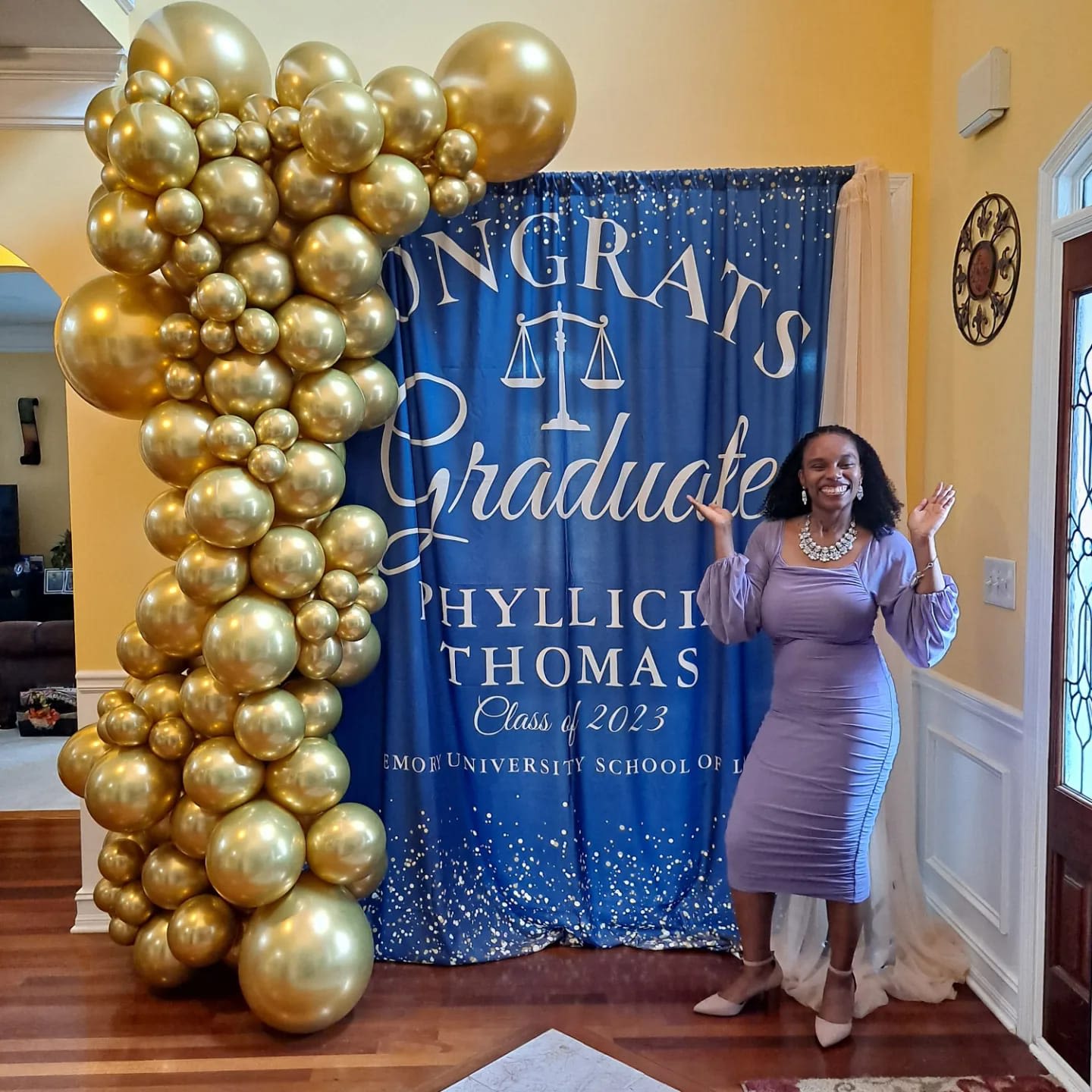
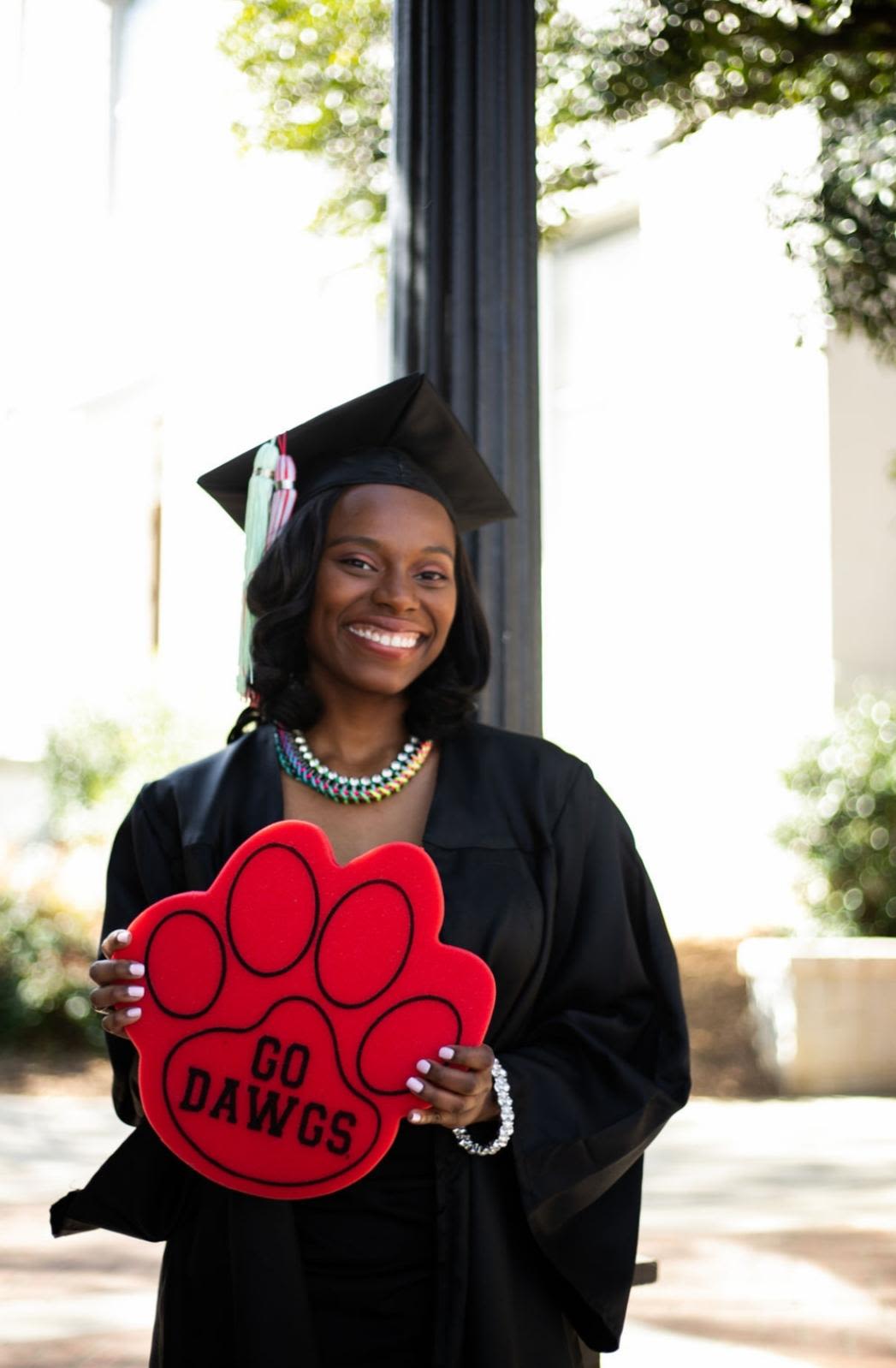
Phyllicia Thomas graduated from the UGA College of Agricultural and Environmental Sciences in May 2019 with a bachelor's degree in environmental economics and management.
Phyllicia Thomas graduated from the UGA College of Agricultural and Environmental Sciences in May 2019 with a bachelor's degree in environmental economics and management.
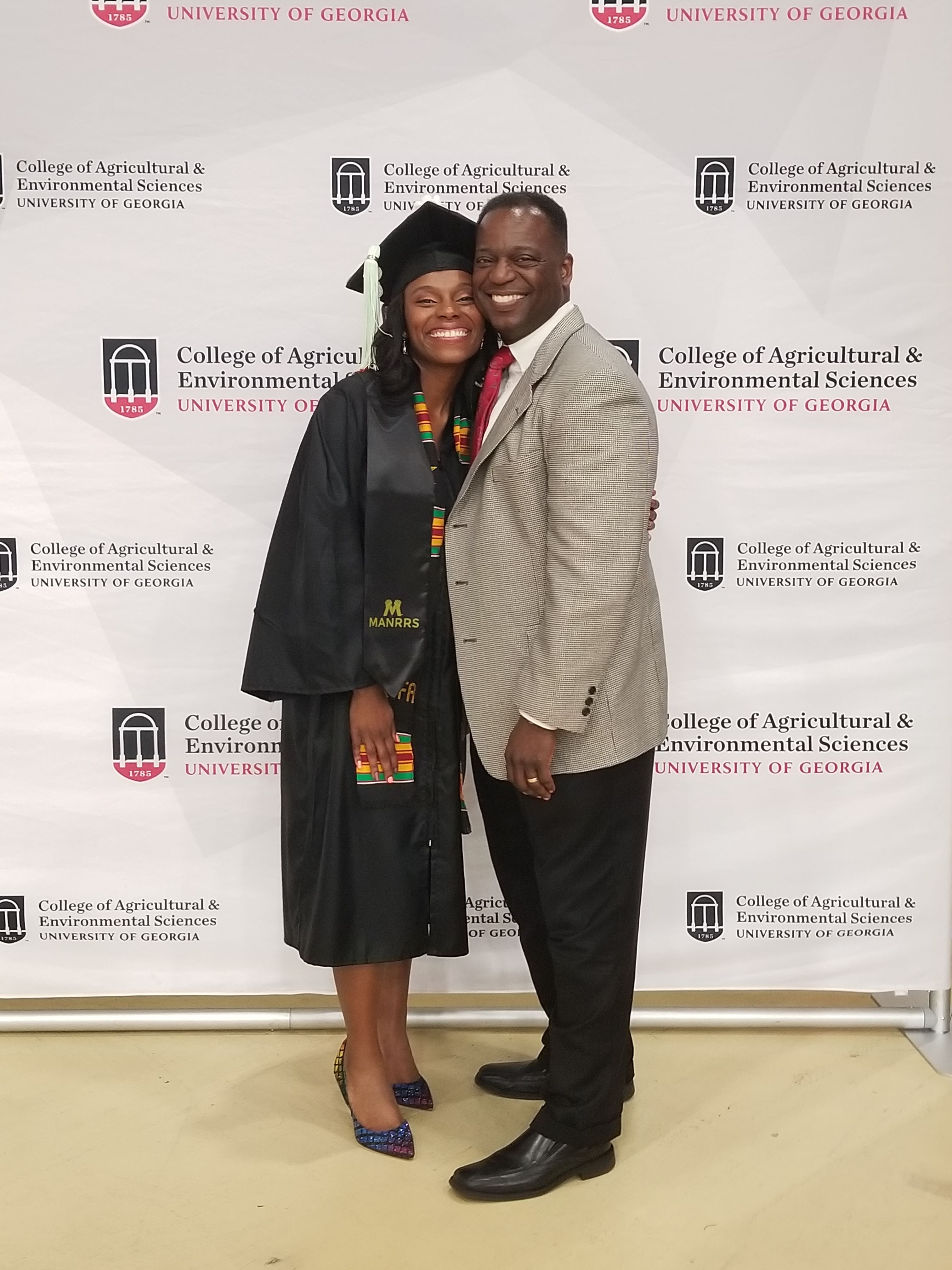
Phyllicia Thomas and her father, Chris Thomas, pose in front of a backdrop at her 2019 graduation from CAES.
Phyllicia Thomas and her father, Chris Thomas, pose in front of a backdrop at her 2019 graduation from CAES.
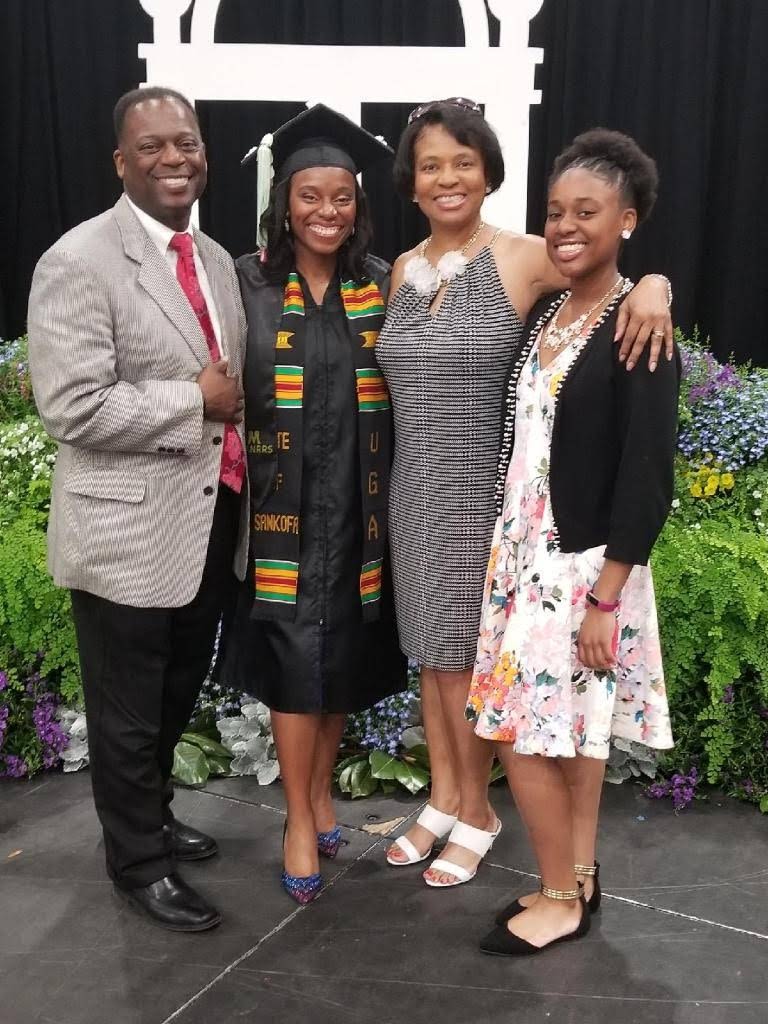
Chris, Phyllicia, Arlene and Julianna Thomas at Phyllicia's 2019 graduation from CAES.
Chris, Phyllicia, Arlene and Julianna Thomas at Phyllicia's 2019 graduation from CAES.
When Phyllicia Thomas walked across the stage to accept her degree in environmental law in December 2023, it was the culmination of two journeys — one toward a dream set upon as a high school student and the other an unforeseen detour she navigated with determination and the steadfast support of her family.
Thomas embarked on the second journey just over a year after graduating from the University of Georgia’s College of Agricultural and Environmental Sciences with a bachelor’s degree in environmental economics and management in May 2019.
It was June 3, 2020, and Phyllicia had just completed her first year in the environmental law program at the Emory University School of Law in Atlanta. That day she was driving with her mother, Arlene, and her younger sister, Julianna, to shop for a Father’s Day gift for her dad, Chris, when their car was struck by a speeding truck.
All three women were hurt in the crash, but Phyllicia, the most gravely injured, was flown by helicopter to Atlanta Medical Center’s level-one trauma center. Julianna, who sustained a concussion and cuts from broken glass, was released the day of the accident. Arlene, who also suffered a concussion as well as significant facial and pelvic fractures, was hospitalized for a few weeks.
Chris remembers the telephone call from his nephew telling him that there had been an accident.
“It was about 5 to 8 miles from the house. I made it to the scene and saw emergency vehicles and ambulances, at least three. They’d landed a helicopter on the golf course there to life-flight her,” Chris said. “All they could tell me was that they’d been able to get Phyllicia’s lungs reinflated, so I knew there was hope.”

Phyllicia Thomas' car after she and her family were struck by a speeding truck in June 2020.
Phyllicia Thomas' car after she and her family were struck by a speeding truck in June 2020.
Phyllicia would remain at Atlanta Medical Center, in a nearly coma-like state, for 28 days.
“They told us she was minimally responsive, which the doctors said was one close step from a full-blown coma,” Chris explained. “The only difference is that Phyllicia would have a minimal amount of response. They knew there was some brain function because if they asked her to squeeze three times with her right hand, she might do it one or two out of three times, but there was no response on the left and no other body movements.”
As the weeks passed with no significant change in Phyllicia’s condition, Chris said he was encouraged, although his daughter was on a ventilator to help her breathe.
“They told me she was on the first setting on the ventilator, which is the least amount of assistance needed. To me, that was good news. I got a sense of calm because I knew this was a traumatic brain injury and it was going to take time. The brain is complex. We knew God was still working, we just had to give it time to heal.”
While she has no memory of the crash, or even of the days leading to it, Thomas recalls gradually becoming aware after she was transferred to the Shepherd Center, an Atlanta hospital specializing in treatment and recovery from brain and spinal cord injuries.
While the rest of the world was in the thick of the COVID pandemic, Chris was allowed to join his daughter at Shepherd if he tested negative for the virus. The condition was that he could not leave — so he stayed. His younger daughter, with the help of other family and friends, helped his wife recover at home while he settled in to support Phyllicia.
After about a week at Shepherd, the medical staff began trying to wean Phyllicia from the ventilator, five minutes at a time, then 10 minutes, until she went a whole day breathing on her own. After a precautionary overnight period, she was finally removed from the ventilator entirely.
“Then she started to emerge. She did not speak for a while, she was still in a sleeplike state, but they would sit her up in a chair using a lift. They would speak to her and ask her questions. I remember they gave her a washcloth and asked her what she would do with it. She took it and wiped it across her face. That was about 35 days after the accident,” Chris said. “It was really slow, but she would try to follow commands and she was more consistent when I would ask her to squeeze my hand or she’d give a thumbs up or thumbs down to indicate whether she was in pain.”
In the meantime, Chris did everything he could think of to bring his daughter comfort and aid in her recovery, talking to her, rubbing lotion on her hands and feet, and playing music, a pastime they shared.
“I would pick things I knew she liked. I asked her sister who her favorite artist was, and she said Mariah Carey, so I would play Mariah Carey’s greatest hits. She was also in marching band in high school and she loved the movie Drumline, so I pulled that up on my phone and played it,” Chris said. “Once while I was playing it, before she could even open her eyes all the way, the main line came and she raised her eyebrows and smiled and nodded. I played that a lot.”
About a week after coming off the ventilator, Phyllicia began to try to communicate.
“I remember being aware in stages. At first, I could not see anything, but I could hear the nurses coming in and out. When I emerged, which is what they call it when you wake up, I was still intubated and I couldn’t talk,” Phyllicia said. “I remember trying to ask for a phone so I could type and text what I wanted to say. There was a lot of pointing until they understood what I wanted.”
Realizing what she was asking for, Chris handed his eldest daughter his phone. She immediately opened his Gmail app and started a new email to type her questions to him.
“In classic form, she wrote ‘Things I need to know: One, are Mommy and Julianna OK?’ Two, was about law school. She wanted to know if classes had started already. Three was whether she had missed her sister’s birthday, because it was her sister’s sweet 16 on June 26. Then she just looked at me with big eyes,” Chris said. “I was truly amazed. Speechless. From that moment of overwhelming joy, I knew she was on the comeback trail, slowly and surely, at whatever pace she needed.”
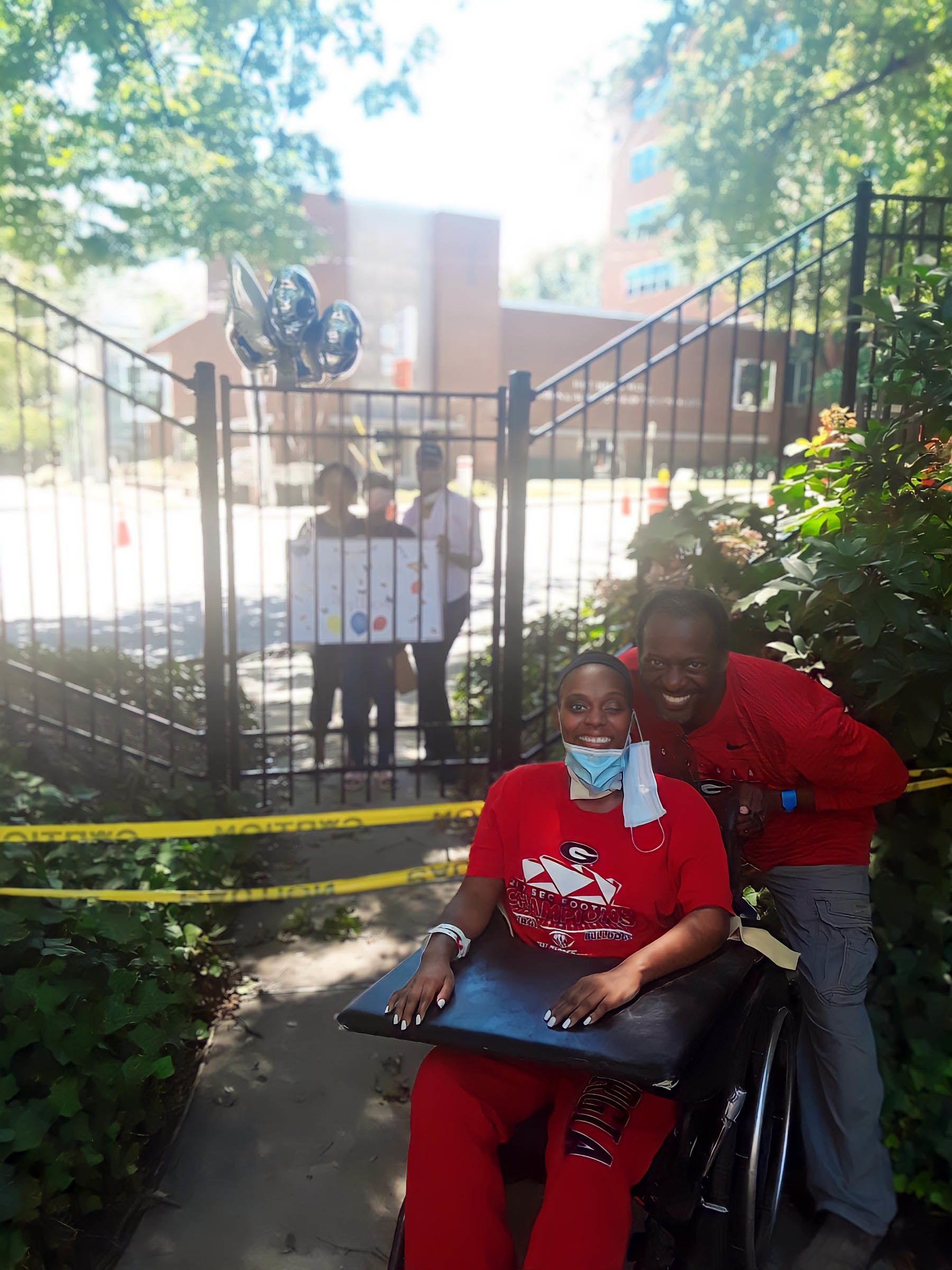
Phyllicia Thomas and her father, Chris (foreground), on the grounds of Shepherd Center, where she spent three months recovering from a traumatic brain injury after a traffic accident. In the background, family and friends who could not come inside due to COVID pandemic restrictions hold a sign saying "Prayers for Phyllicia."
Phyllicia Thomas and her father, Chris (foreground), on the grounds of Shepherd Center, where she spent three months recovering from a traumatic brain injury after a traffic accident. In the background, family and friends who could not come inside due to COVID pandemic restrictions hold a sign saying "Prayers for Phyllicia."
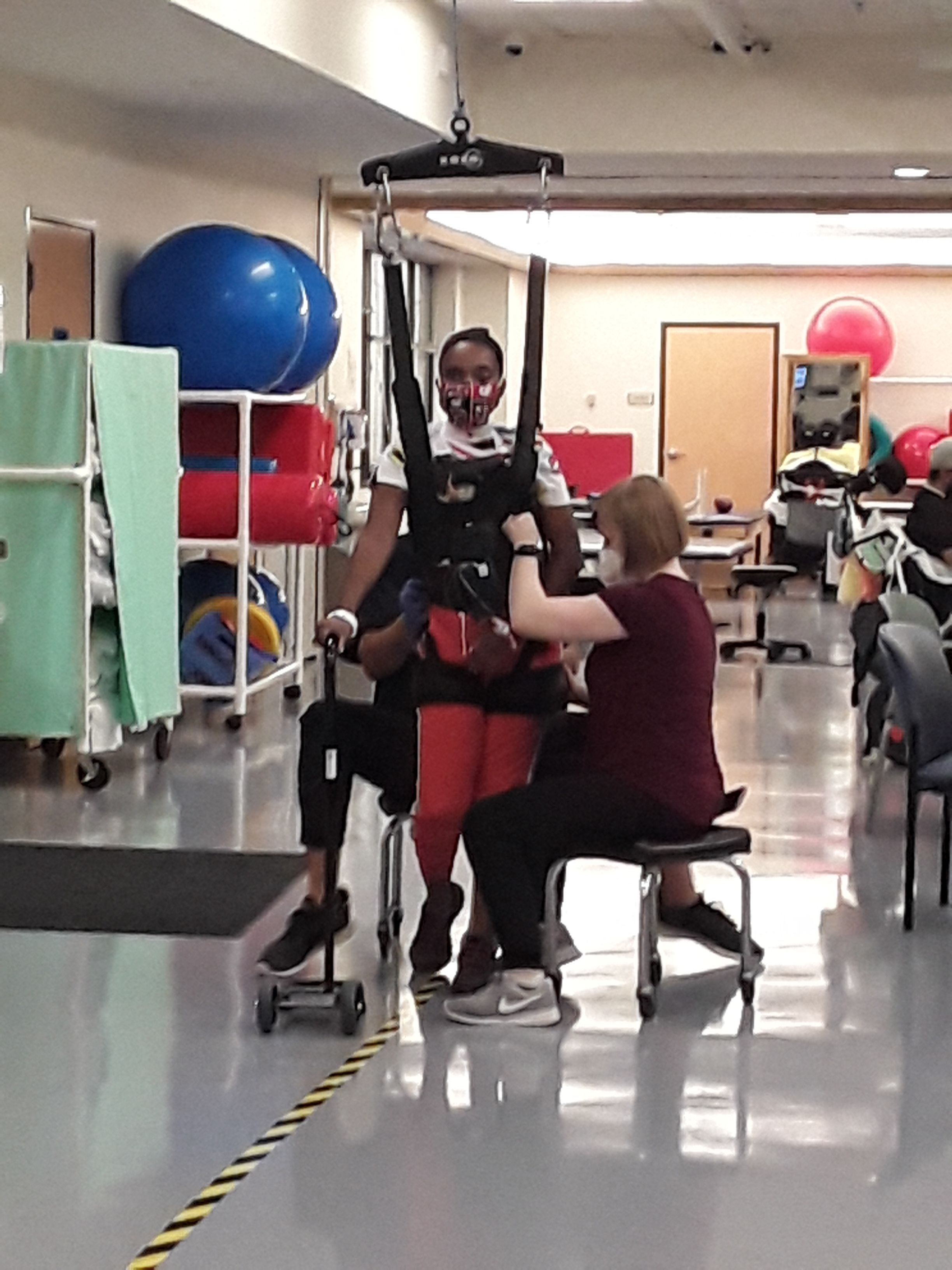
While at Atlanta's Shepherd Center, Phyllicia Thomas had to relearn many everyday tasks, including walking, talking and writing.
While at Atlanta's Shepherd Center, Phyllicia Thomas had to relearn many everyday tasks, including walking, talking and writing.
From that moment, Chris said he had no doubts about his daughter’s determination to achieve her goal, despite the long journey ahead.
Phyllicia remained an inpatient at Shepherd until Sept. 2, 2020, followed by nine months of daily therapy at Shepherd Pathways, the hospital’s outpatient rehabilitation program. Chris and Arlene, who had recovered sufficiently by the time Phyllicia was released, took turns shuttling her to therapy Monday through Friday so she could relearn almost everything — how to swallow, to speak, to walk, to write.
Many times, Chris would watch Phyllicia during therapy sessions. He remembers therapists using a machine to help her learn to walk again. From the end of a hallway, he watched her walking away from him in laborious steps. He saw her legs shaking with fatigue, then he heard the nurses ask Phyllicia if she was in pain. She nodded. They asked her if she wanted to stop. She shook her head no and kept pushing.
“Phyllicia is a really hard worker. She’s always been so determined. If she makes her mind up on something, she is going to make it happen,” Chris said. “To watch a child with so much fight and desire to get better — it is amazing. The staff would say she was the hardest working patient they had. She never quit.”
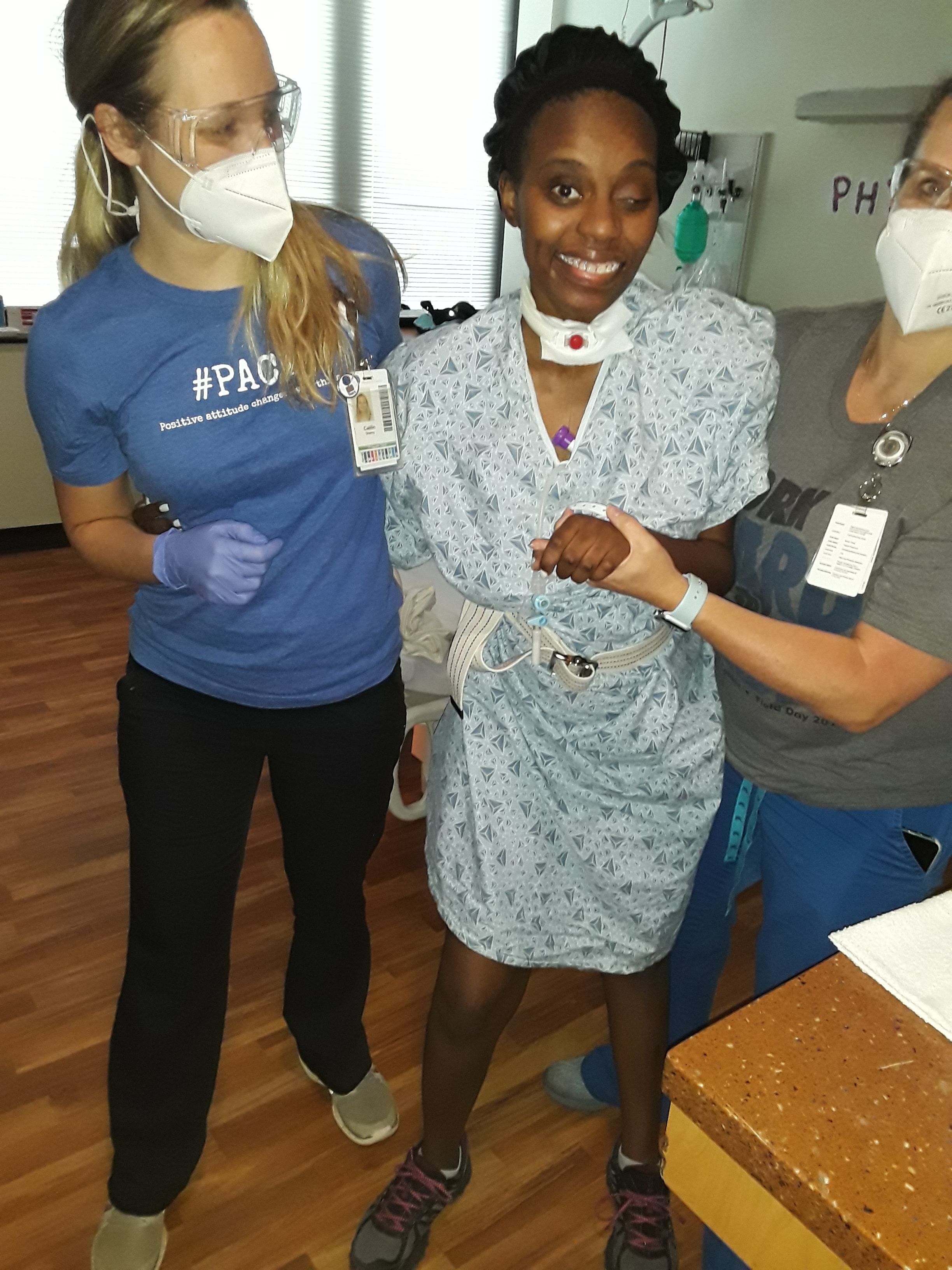
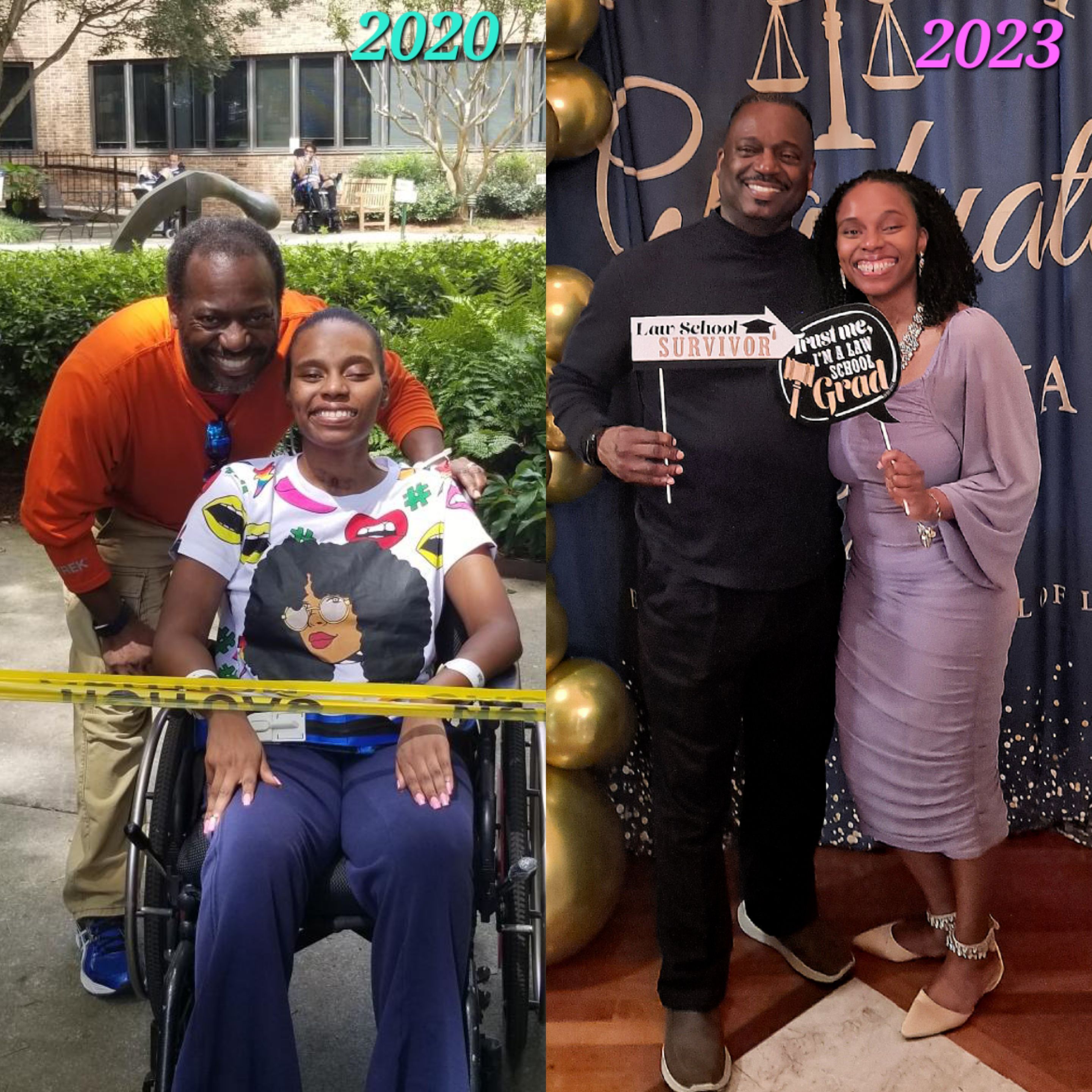
Phylicia Thomas with her father, Chris, during her recovery at the Shepherd Center (left) and at her Emory School of Law graduation (right).
Phylicia Thomas with her father, Chris, during her recovery at the Shepherd Center (left) and at her Emory School of Law graduation (right).

Chris, Julianna, Phyllicia and Arlene Thomas celebrate Phyllicia's graduation from law school.
Chris, Julianna, Phyllicia and Arlene Thomas celebrate Phyllicia's graduation from law school.
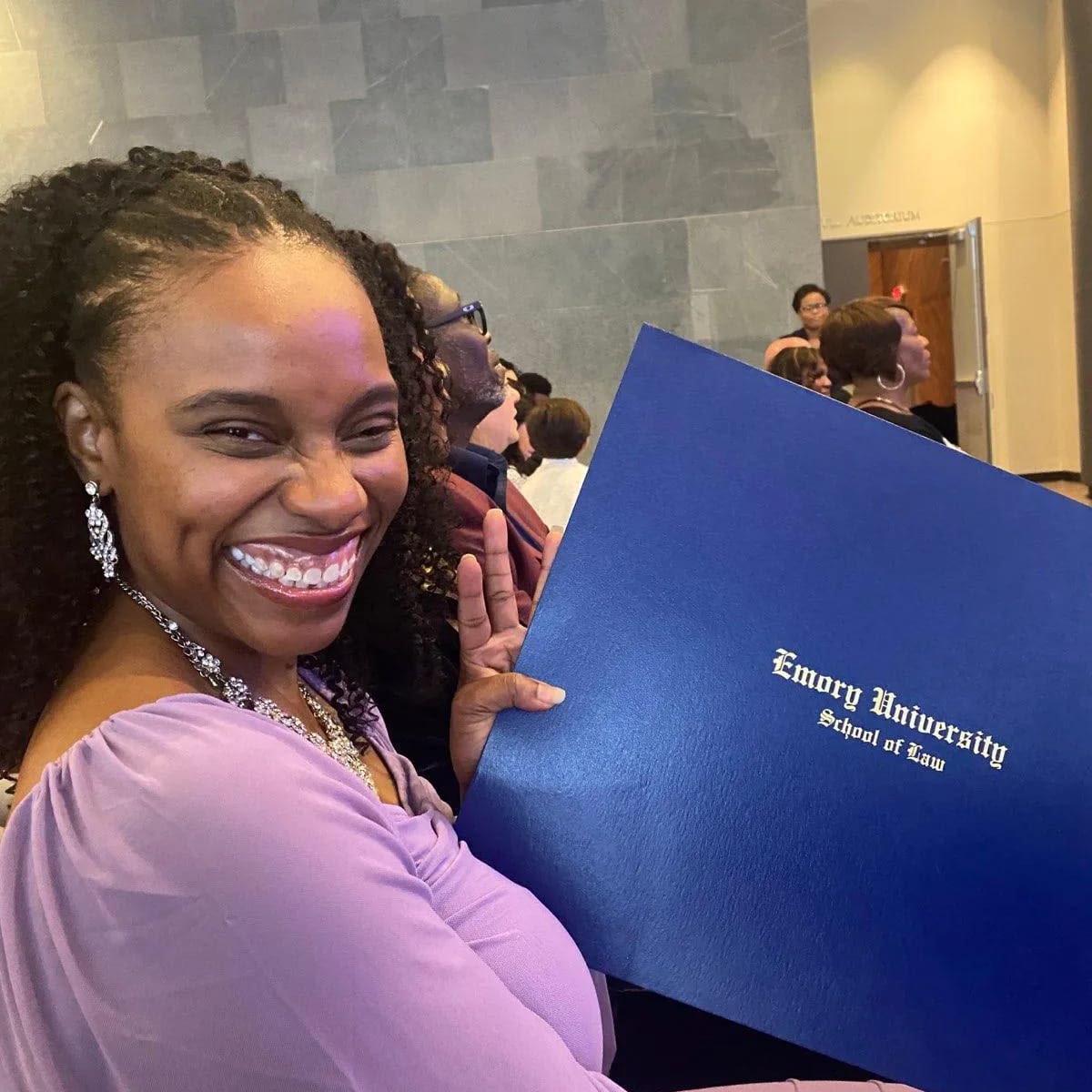
Phyllicia Thomas proudly displays her law degree.
Phyllicia Thomas proudly displays her law degree.
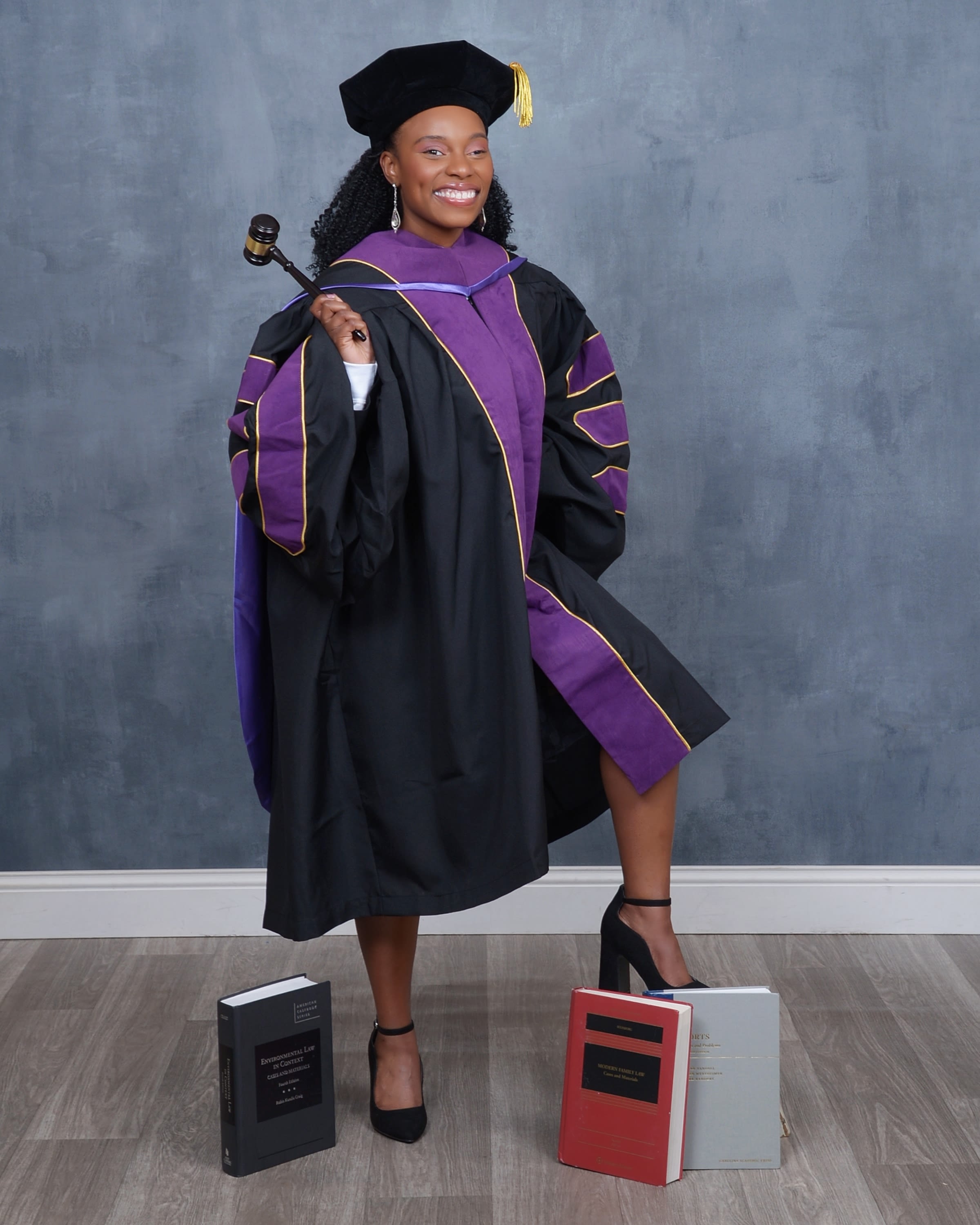
Phyllicia Thomas poses with a gavel and books to mark her graduation from Emory University School of Law.
Phyllicia Thomas poses with a gavel and books to mark her graduation from Emory University School of Law.
Almost a year after the accident, Phyllicia was finally cleared to return to Emory School of Law, which she did in fall 2021.
“What really got me through it was being driven and stubborn and wanting to go back to law school,” Phyllicia said, laughing. “Having Dad in the hospital with me gave me reassurance and hope when I didn’t think I’d get out. Having him there, especially when he played music for me, reminded me of life before the accident, what is attainable and possible if you work hard — and what I wanted to get back to.”
But going back to law school wasn’t easy. The cohort she started law school with had moved on during her recovery and she initially only returned to classes part-time.
“I felt isolated and alone. As a part-time student I felt like I was floating in the middle of nowhere. Usually you are a 1L, 2L or 3L (first-, second- or third-year law student), there’s not really a 1.5L. Once I got back to school, they did well on testing accommodations, but my cognitive function and how I learned things were different,” Phyllicia said. “Sometimes I needed to hear something repeatedly or in different mediums. I would record my classes and lectures, and right after class I would listen to the recording again from my laptop. I would email or ask my professors questions if I wasn’t sure about something after rereading texts multiple times. Giving myself grace, knowing I wasn’t going to get 100% of everything right off the bat, helped. One thing that kept me motivated is having the strong support of my family.”
While she had planned to graduate in May 2024 at Emory’s spring commencement ceremony, she realized during the fall 2023 semester that she had completed her coursework and was approved to graduate in December.
“The last week before I graduated, I was teary-eyed the whole week. It was really happening, I was really about to graduate,” Phyllicia said. “It’s crazy. Now I look back and I can’t believe that happened or that I did that. I wish I could go back and tell me in the hospital bed ‘You are going to get out of this and graduate from law school.’ It was an awesome feeling to know I accomplished that.”
Earning her law degree is both the realization of an aspiration that began in high school and the beginning of her dream to work in environmental justice.
Growing up, she’d visited many national parks on vacations with her family and pored over the issues of National Geographic that were delivered monthly to her family’s home. While in class at Arabia Mountain High School in DeKalb County, Phyllicia watched a documentary on environmental law and was immediately captivated by the idea.
“I have always had a love and appreciation for the environment and came to realize that access to a healthy environment can be ripped away and stripped from people because of race and income. Everyone should have the same opportunity for the same enjoyment of the environment,” she said. “I was really interested in environmental issues and how you could use the law to fix them.”
During the summers before her junior and senior years of high school, Phyllicia participated in the Young Scholars Internship Program at CAES, where she worked with CAES professors and graduate students and learned about the environmental economics and management major in the Department of Agricultural and Applied Economics.
“I loved my experience at the College of Agricultural and Environmental Sciences. It made a large university feel more focused and personalized. The college was like a smaller family, and it felt like what you were doing was important to other people,” she said. “It was great to learn not only from the professors but from other students whose families were farmers and their perspectives.”
John Bergstrom, a professor emeritus of agricultural and applied economics, describes Phyllicia as “one of the best students I had the opportunity to teach, advise, and interact with during my 36-year career at UGA,” citing her academic record and her “keen focus on and dedication to her chosen career path” to study and eventually pursue a career in environmental law.
“She graduated with honors from CAES and was admitted to the prestigious School of Law at Emory University. She completed the law degree program at Emory facing not only the normal rigorous academic work at Emory Law but also overcoming enormous personal health challenges,” Bergstrom said. “Her strong character and ability to persevere to complete her law degree is consistent with the Phyllicia I knew at UGA who was always positive, hardworking and deeply committed to her life goals. I know she will continue to be successful in life and a force for good in all her spheres of influence.”
Phyllicia credits classes with Bergstrom and other CAES professors for equipping her with the tools she needed during law school.
“They granted me a different outlook on laws and cases and allowed me to relate how the environment affects the bottom line and what the incentives are to enforce policy regulating it,” she said. “On a deeper level, at CAES I learned about the intricacies of how the environment and environmental change can affect crops or inform a myriad of issues that can really affect someone’s livelihood. It is bigger and broader than I imagined, and it really fueled me to work in environmental law and environmental justice. I really want to be a person who helps enforce some of the changes that need to be made.”
While at CAES she was very involved in the Minorities in Agriculture, Natural Resources and Related Sciences (MANRRS) club and with the Office of Diversity and Inclusive Excellence.
“Coming from where I grew up, which was a predominately Black area, into a place where I was in the minority was difficult, but having groups like MANRRS in the College of Agricultural and Environmental Sciences helped me feel like I was not alone. You know there are people who look like you and who are interested in the same things as you,” Phyllicia said. “It is difficult when you don’t see yourself represented in a space, so having those groups and the diversity office helped give me that sense of belonging and to feel like I was a part of the college.”
Since earning her law degree, Phyllicia has focused on studying for the Georgia Bar exam so she can begin practicing law.
“I want to do environmental justice or environmental racism work for a nonprofit or public interest organization, working for a cleaner and better environment and stopping bigger companies from polluting lower socioeconomic areas,” she said. “We are on a path now that we can’t sustain with the environment. We need to do the public work of making the world a better and cleaner place where people aren’t subjected to harsher environmental conditions because of race, ethnicity, income or zip code.”
Visit caes.uga.edu to learn more about the college's diversity programs and the CAES Office of Diversity and Inclusive Excellence.
To discover how to earn a degree in environmental economics and management, visit agecon.uga.edu, and get involved with CAES alumni at caes.uga.edu/alumni.


